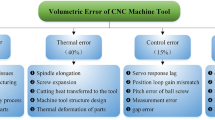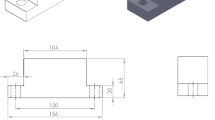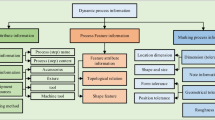Abstract
Off-line feedrate scheduling is an advanced methodology to automatically determine optimum feedrates for NC code modification. However, most existing feedrate scheduling systems have limitations in generating the optimised feedrates because they use the material removal rate or the cutting force model which is dependent on cutting conditions. This paper proposes a feedrate scheduling system based on an improved cutting force model that can predict cutting forces accurately in general end milling situations. Original blocks of NC code were divided into smaller ones with the optimised feedrates to adjust the peak value of cutting forces to a constant value. The acceleration and deceleration characteristics for a given machine tool were considered for realistic feedrate scheduling. Moreover, a modified type of Z-map model was developed to reduce the entry/exit angle calculation error in the cutting force prediction and named the moving edge node Z-map (ME Z-map). Pocket machining experiments show that the proposed method is accurate and efficient in maintaining the cutting force at a desired level.













Similar content being viewed by others
References
Wang WP (1988) Solid modeling for optimizing metal removal of three-dimensional NC end milling. J Manufact Sys 7(1):57–65
Jang DJ, Kim KS, Jung JM (2000) Voexl-based virtual multi-axis machining. Int J Adv Manufact Technol 16(10):709–713
Spence AD, Altintas Y (1994) A solid modeller based milling process simulation and planning system. J Engin Indust 116:61–69
Tarng YS, Shyur YY, Lee BY (1995) Computer-aided generation of the cutting conditions in pocket machining. J Mater Process Technol 51:223–234
Lim EM, Menq CH (1997) Integrated planning for precision machining of complex surfaces. Part 1: cutting-path and feedrate optimization. Int J Mach Tool Manufact 37(1):61–75
Chu CN, Kim SY, Lee JM, Kim BH (1997) Feed-rate optimization of ball end milling considered local shape features. Annals CIRP 46(1):433–436
Feng HY, Su N (2000) Integrated tool path and feedrate optimization for the finishing machining of 3D plane surfaces. Int J Mach Tool Manufact 40:1557–1572
Fussell BK, Jerard RB, Hemmett JG (2001) Robust feedrate selection for 3-axis NC machining using discrete models. J Manufact Sci Engin 123:214–224
Yun WS, Cho DW (2000) An improved method for the determination of 3D cutting force coefficients and runout parameters in end milling. Int J Adv Manufact Technol 116(12):851–858
Yun WS, Cho DW (2000) An improved cutting force model considering the size effect in end milling. In: Proceedings of the ASME International Mechanical Engineering Congress and Exposition, Orlando, Florida, 5–10 November 2000
The outline of the machining center and NC programming manual. Daewoo Heavy Industry, Ltd.
Acknowledgements
This work was supported by the Korean Research Foundation, grant no. KRF-2000-041-E00092.
Author information
Authors and Affiliations
Corresponding author
Rights and permissions
About this article
Cite this article
Lee, H.U., Cho, DW. An intelligent feedrate scheduling based on virtual machining. Int J Adv Manuf Technol 22, 873–882 (2003). https://doi.org/10.1007/s00170-003-1609-y
Received:
Accepted:
Published:
Issue Date:
DOI: https://doi.org/10.1007/s00170-003-1609-y




